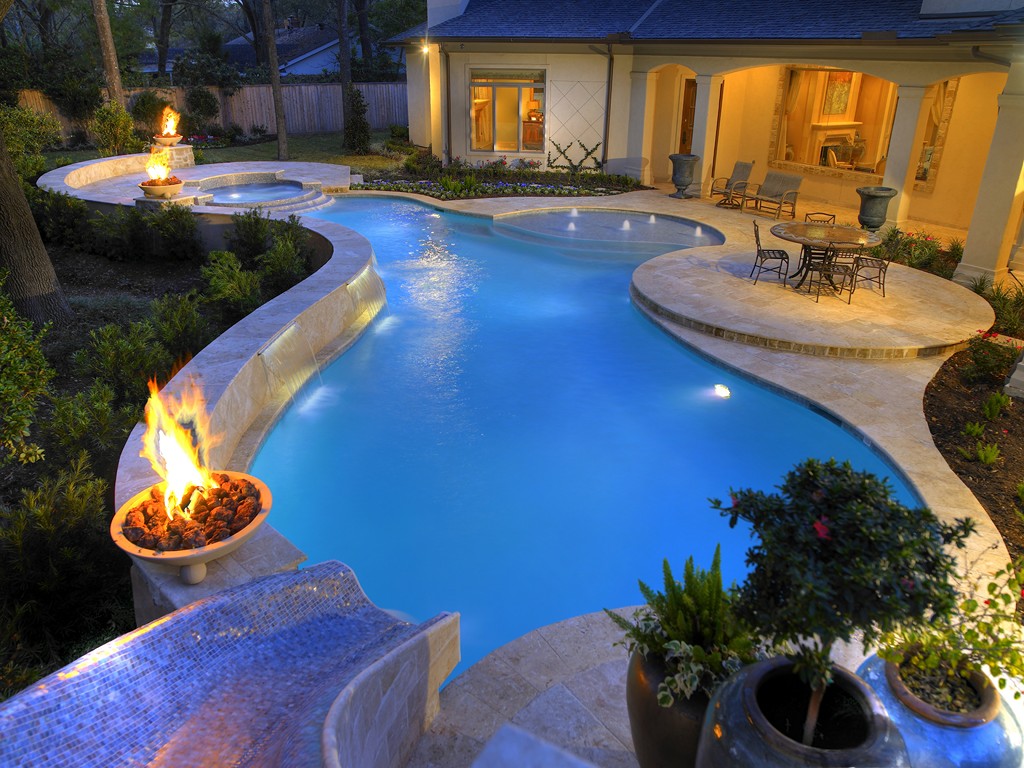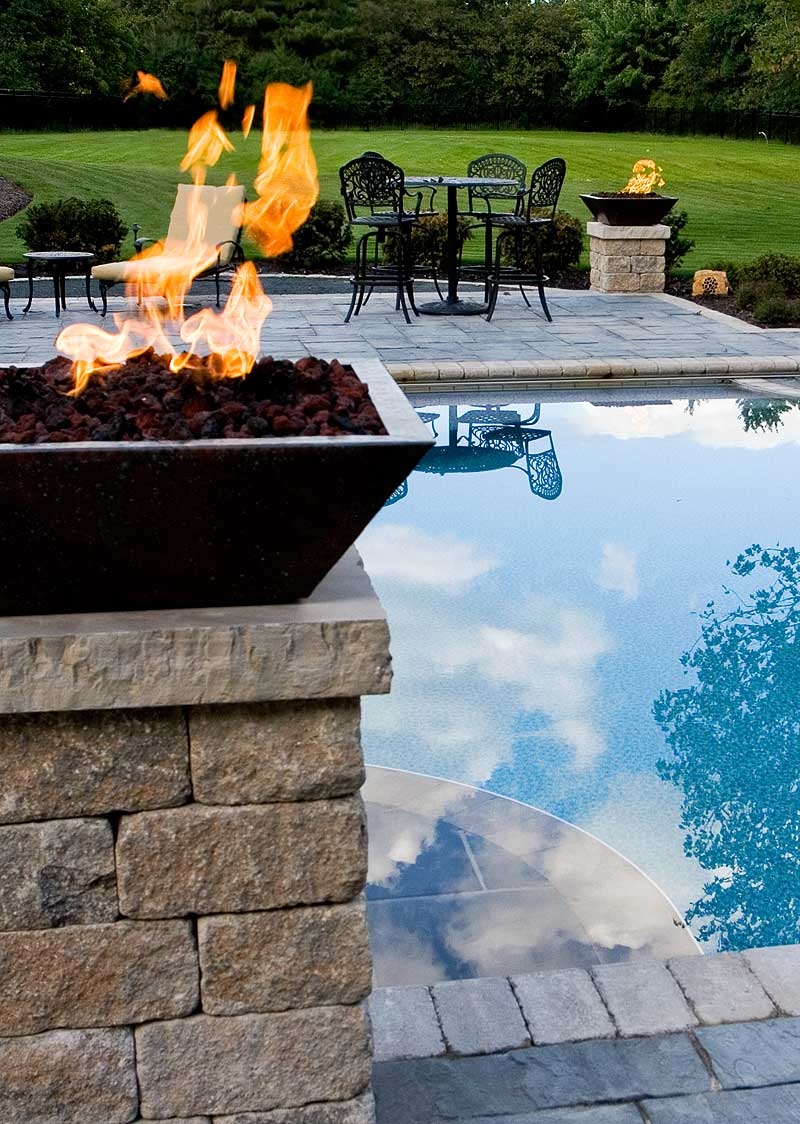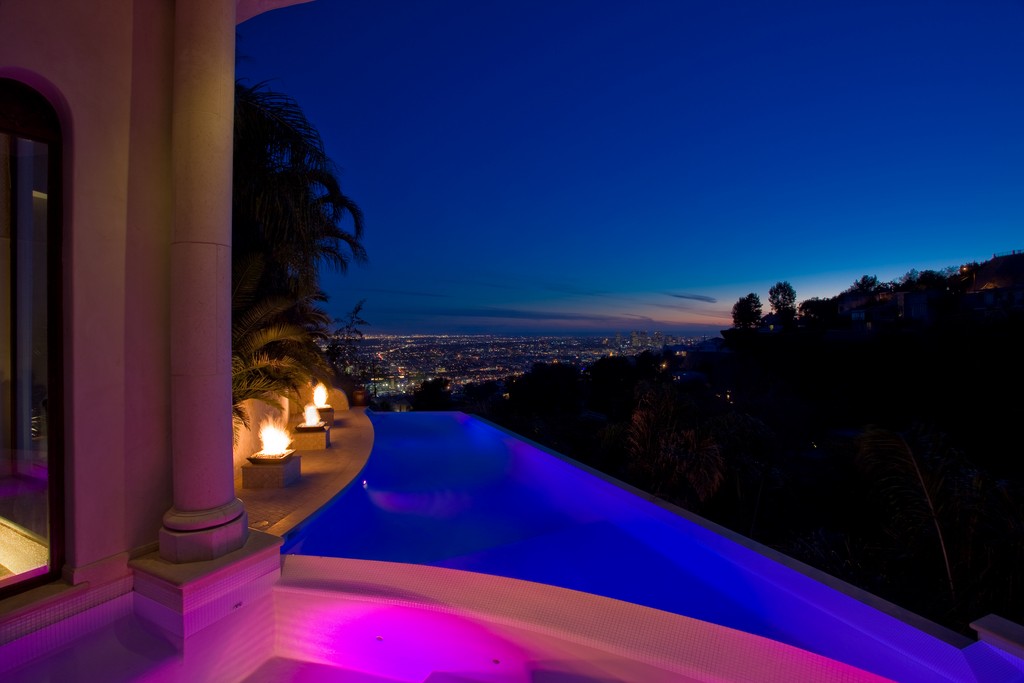A Flair with Flames

Fire effects have grown tremendously in popularity in recent years, especially among swimming pool designers and builders who use them in developing various fire-on-water features.
On one level, it seems that these professionals (and their clients) have noticed that systems that contain and control fire serve as wonderful complements to systems that contain and control water. On a grander scale, however, it’s apparent that, as watershape designers and builders have become more and more creative, fire features have risen in the estimation of those who want to give their clients something special – something few others have.
At my company, Grand Effects of Irvine, Calif., we’ve focused on making it easy for watershapers, general contractors and landscape designers and architects to bring fire into the picture across a range of applications. To that end, we’ve developed an array of completely off-the-shelf systems, ready to install, and have done all of the engineering and testing required to build confidence into every product.
In doing so, we’ve studied possible effects and developed systems that tap into fire’s elemental appeal across a broad spectrum of applications. In particular, we’ve explored combinations of fire and water, our conclusion being that we’ve only begun to scratch the surface when it comes to exploiting their amazing synergies.
LIVES OF THEIR OWN
So much of this is unexpected, because fire and water are typically seen as having opposite characteristics. But it’s actually quite the contrary: In fact, when it comes to using fire in the vicinity of water, we’ve come to observe several important and even profound similarities.
Both fire and water can be extremely dangerous, for example, yet both bring life. They can both be soothing and exciting; bring distinctive points of interest to landscapes; serve as warm, welcoming gathering places; and carry tremendous cultural and even spiritual meanings.
And because both fire and water can cause tremendous damage when not contained properly, those who design with and install these systems must know a thing or three about how to use them effectively and safely in either residential or commercial settings.
Now that more and more of these systems are out there in conjunction with watershapes, the feedback we’ve gotten tells a compelling story: For whatever aesthetic or sociological or psychological reason people care to summon up, fire and water are a perfect fit.
Indeed, there’s a yin/yang relationship between the two that creates fascinating tension and simultaneous harmony within a scene. Firelight reflecting off the water’s surface lends a mysterious, even mystical quality to a setting, while water emitting from a fire structure is counterintuitive and fascinating. And where water provides a soothing cooling factor in hot weather, fire offers complementary warmth to a space when the air turns chilly.
| Fire features gained their original (and still enjoy much of their enduring) popularity as space heaters – purely functional units that keep people warm and happy to be outside when a chill fills the air. |
On its own, fire offers a form of illumination that is unlike any that can be achieved using electricity. Its ephemeral quality and dancing motion are hypnotic and entertaining to human beings in ways matched only by motion pictures and television – the only other visual effects I can think of that motivate people to sit and watch quietly in darkened spaces for extended periods of time.
It’s reached a point where we can take all of those impressions and emotions and think about them in practical and even cold commercial terms. This is why fire shows up in so many restaurants: Fire pits and fireplaces entice people to sit while consuming food and beverages and in that sense have taken on direct revenue-generating roles. This ability to attract attention also explains why fire figures so prominently in the entrances to hotels and casinos.
Boiling it down, fire provides an elemental brand of fascination that simply cannot be obtained in any other way, and with ready-made systems now widely available from a number of suppliers, designers and builders are now seeing a multiplicity of ways to use fire in adding value to their work.
MANY FORMS
The role of system suppliers in all of this is simple: We’re here because the vast majority of designers and builders have a healthy respect for fire and aren’t inclined to improvise or try to cobble together systems on their own. So we take on system development and testing – and all of us have learned in the process that these are indeed specialty items that take time to master.
In that sense, what we do is analogous to sculptors or statuary companies that offer decorative items meant to increase the beauty, interest and value of an overall project. Very few landscape architects or pool contactors are interested in becoming sculptors themselves, so they seek outside sources and assign them responsibility for what often turn out to be highly significant aspects of these projects.
Fire functions in that same sort of role, and time and time again we’ve heard from homeowners or property managers who say that it’s become the favorite part of their swimming pool, fountain or landscape design. To meet that need and the different sets of expectations different clients always have, we’ve created families of products that enable designers to go simple – or mix and match different features and materials to come up with looks that appeal to the specific needs of certain clients.
In order to be effective in this marketplace, we’ve spent a great deal of time listening to what people tell us – professionals and consumers alike – about what they need or want. By doing so, we’ve been able to develop ranges of systems in various sizes, shapes and styles for use in an array of settings.
In our case, we also will tackle custom configurations on request, but given the expense associated with developing and testing these fabrications for safety and performance, most of our clients select from among our standard pieces (fire pits, fire-pit inserts, rock inserts, vertical torches, fire-and-water bowls, wall torches and more) and then focus on making things unique with materials and creative placements within overall compositions.
| In recent years, fire has increasingly been used strictly for its decorative potential. These units may warm the occasional passerby, but they’re basically there to create a visual focus, draw the eye to a desired perspective, call attention to key structures or bring a sense of dynamic, continuous motion to otherwise static settings. (Photo at top left courtesy Landmark Pools, Ladera Ranch, Calif. Photos at left middle and right middle courtesy Bella Vista Pools, Corona, Calif. Photo at right courtesy Down Unda Pools, Houston.) |
Through the years, we’ve found that by keeping things simple, we offer a resource that works with a broad range of architectural and landscape styles, from the very traditional to the highly contemporary. By working with basic linear and curvilinear forms, we make certain our features don’t get in the way when it comes to a project’s overall look, whether the need is to create a small accent or frame a vanishing-edge detail.
We’ve also found that, even with the growing acceptance of fire features in watershape and landscape settings, this is still a major way to bring uniqueness to a project: It’s human nature to want to have something different from what everyone else has, and in that sense we’re in the business of making that perceived exclusivity a reality.
MATERIAL CHOICES
In developing our systems, we’ve encountered a range of materials that can be used in effectively containing fire.
Chief among these when it comes to providing flexibility in terms of appearance is glass-fiber-reinforced concrete (GFRC), which is both relatively lightweight and extremely durable. As those of you who work with decorative concrete or artificial rockwork already know, it’s a medium that works across styles and in an almost limitless range of colors and textures.
At our company, we achieve different looks with GFRC using various combinations of stains and washes. We’ll pour the concrete in a base color and engage in processes that can take up to a week in which we’ll treat the concrete with layers of stains and washes to create colors and textures that are integral, not just on the surface. (Paint is out of the question for coloring these items: It will invariably crack and chip when exposed to fire, treated water and the elements.)
We also use lots of copper – another material that holds up very well in the presence of both water and fire. Ours is sourced from a place in Mexico where artisans use a traditional method of pounding and firing the copper in a unique combination of flames and smoke – the result being a beautiful and incredibly durable material. (As a rule, it’s more practical to do purely custom work in copper than in concrete because of the costs associated with preparing concrete molds.)
As suggested in passing above, a number of our systems involve placing water right in the fixture with the fire elements – mainly in the form water spilling out of fire bowls, either through scuppers or over the bowl’s rim. In the latter case, the water and fire appear to emerge from the same surface, although in our systems they’re never in contact with each other. (Some companies offer these direct-contact systems, but we never have.)
| Through the years, the materials used in fire pits and bowls have come a long way in design terms. From lava rocks and sculpted concrete to various colors of glass, these options enable designers to fit their fiery ideas into a number of styles, from classic to contemporary. |
Once the effect and the form are selected, a big dose of design flexibility comes with the choices of materials used to fill the fire containers. We provide traditional lava rock, which is prized for its chunky, porous, dark-brown/red appearance; we also change things up with an “accented” lava rock (featuring a prismatic blue look), lava spheres (a beautiful architectural look); tempered fire glass (available in various colors); and a material made from basalt, a beautiful natural stone.
Even staying with our off-the-shelf product list, the options available with materials, finishes, sizes, shapes and accessories give designers plenty of leeway in striving for the unique as well as the practical.
TECHNICAL RESPONSIBILITY
At a certain point in all of this comes the recognition that, after all, we are in some sense playing with fire: Aesthetic flexibility is one thing, but when it comes to installing and living with these systems, reliability, safety and sheer practicality take over and assume paramount importance. Let’s face it, if systems that contain fire are not made to high standards, failure is a distinct possibility – and danger a reasonable one.
The upshot is that we allow no room for compromise on the fundamental technical features of our products. This is why we deal primarily in turnkey systems that require little or no on-site assembly: At this point in these products’ developmental history, it’s simply unreasonable to expect those with expertise in setting equipment pads, pouring decks or planting trees to become proficient overnight in installing fire features by reading a manual.
This is why we keep things as simple as possible with respect to installation and reserve tasks related to engineering, testing and assembly to ourselves.
Our systems all come in one of two basic formats: user-started (meaning the user inserts an ignition key of the sort used with indoor fireplaces and lights the fire himself or herself) or fully automatic.
We offer user-started systems basically to keep system costs down: There’s a real premium when it comes to the fully automated option in which the fire is ignited at the touch of a button. These devices operate on any auxiliary circuit in a pool- or fountain-control system and are housed in their own weatherproof boxes.
In our case, these automatic systems use what is known as flame-rectification technology. This includes a monitoring unit that detects and will shut down when it notices any disruption in the flame’s status. If, for example, the fire effect is on and it starts to rain or the wind kicks up to such an extent that the flame is extinguished, the system turns off the flow of natural gas or propane. Later, when it’s safe to do so, the system will automatically turn on the gas and relight the flame.
As was just mentioned, our systems can work with either natural gas or propane. Propane is two-and-a-half times heavier than natural gas, so in both user-started and automatic systems, we deploy additional safety equipment in the form of an valve upstream of the feature that cuts off the gas flow in the event of a leak or a loosened connection at the feature itself.
SAFETY CONCERNS
When dealing with fire (or water, for that matter), safety is always a paramount concern – and we who are in the business of supplying fire features make it a priority in everything we do.
In our case, we subject every system we develop to extensive testing and submit all components to a range of agencies for approvals. Our control panel (mentioned just above) is approved by Underwriters Laboratories (UL). Our actual fire systems are tested and approved by both the Canadian Standards Association (CSA) and the American Gas Association (AGA). In addition, we adhere to guidelines mandated by the National Fire Protection Agency (NFPA).
| With increasing frequency, designers are finding ways to use fire to spectacular effect – particularly in commercial settings where calling attention to a restaurant, nightclub or hotel entrance is much to be desired. But that doesn’t mean residential applications are far behind: The effects in these contexts range from the surprising to the surprisingly subtle, frequently with beautiful results. (Photos at top left and left middle courtesy Island Projects, Turks & Caicos Islands. Right middle photo courtesy Aqua Construction, Florida. Photo at right courtesy Bella Vista Pools. Lower left photo courtesy Richard Tuil Designs, Los Angeles.) |
We don’t want to take even the remotest chance that a problem will arise – and we see it as our responsibility to assure those who specify and ultimately use our systems that they can feel completely confident that the effects will perform properly and safely.
Such testing and approvals are required in most commercial applications, but fire effects are so new in residential settings that the regulations haven’t quite caught up. (There are a few notable exceptions, including Clark County and the city of Las Vegas in Nevada; Palm Springs, Calif., and Mesa, Ariz.) As we see it, this is a temporary blind spot in the rules, and we wouldn’t consider taking advantage of the situation – there’s simply too much at stake.
Here and elsewhere, we simply apply common sense to what we do, operating within basic principles that we know will enhance the safety and increase the enjoyment of our fire features. Similarly, we’ve come up with a basic set of guidelines we offer to designers and installers to help them come through the process without concern for either performance or safety.
We recommend, for example, maintaining buffering, non-flame zones around each feature. With a fire pit in a commercial application, that means we suggest a minimum 15-inch buffer zone – or more depending on the situation. We also strongly recommend that the features be kept at a reasonable distance from combustible material, including plants that might drop debris into the feature.
Some people find this surprising, but we also recommend against putting most fire features on timers: We want these systems to be activated only when the homeowner or property manager is around to be certain that conditions are safe. We also advise against placing fire features within or immediately adjacent to pathways or other high traffic zones. And we certainly recommend in the strongest possible terms that they be placed in such a way that they are well beyond the reach of children!
We also pitch in with some aesthetic suggestions. Through experience, for example, we’ve learned that elevated fire elements make an incredibly strong impression by creating compelling visuals that can be seen from multiple points in a given space. We also know that fire pits and fireplaces become prime gathering locations, so we always recommend planning for ample seating areas in which people can watch the flames and relax comfortably in the warmth.
Our ambition here is not to call the shots, but to open designers’ and builders’ eyes to the potential of these features and see to it that they’re put to the best possible use. It’s a two-way street: We’re constantly learning from our clients and happily pass ideas along as we see how things work out and our products continue to be used in the field. And truth be told, we are constantly amazed at the design solutions we see.
That’s the great fun of this business: By making reliable, flexible, safe systems, we’ve put ourselves in the wonderful situation of working with designers and installers who have confidence in what we do and share our conviction that fire brings real drama to their projects. What could be better than that?
Kevin Doud is founder of Grand Effects, a fire and waterfeature manufacturer based in Irvine, Calif. He has a bachelor’s degree in mechanical engineering from the California Polytechnic State University and has an extensive practical background in combustion technology gathered in ten years’ employment as an engineer and regional sales manager for a leading manufacturer of industrial combustion equipment. Doud also holds a patent on Grand Effects’ automated burner package.

























